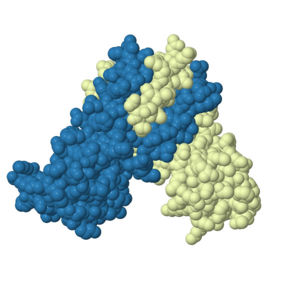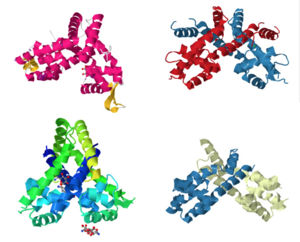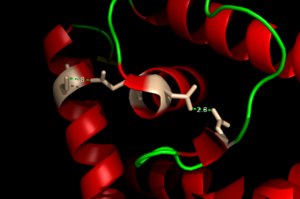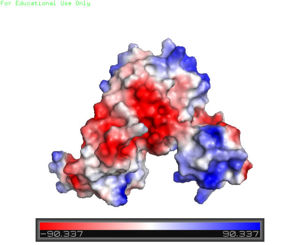Sandbox Reserved 1063
From Proteopedia
| Line 23: | Line 23: | ||
=== Helix-Turn-Helix Domain === | === Helix-Turn-Helix Domain === | ||
| - | The AdcR MarR transcriptional regulator's structure resembles the other proteins in the same family as mentioned before; however, the most notable differences are found in the winged helix-turn-helix (wHTH) motif that assists in binding DNA | + | The AdcR MarR transcriptional regulator's structure resembles the other proteins in the same family as mentioned before; however, the most notable differences are found in the winged helix-turn-helix (wHTH) motif that assists in binding DNA. The major groove of DNA is bound to the recognition helix while the wings grip onto the minor grooves of DNA. The charge map on the right highlights the <font color='blue'>positively</font> charged areas, which stabilize the negatively charged backbone of DNA. Although AdcR is a highly alpha helical protein, the "wings" of the DNA binding domain consist of two anti parallel beta strands that are made up of several positively charged residues. There is a wHTH domain on each monomer of the protein. |
The <scene name='69/694230/Whth/1'>winged helix-turn-helix</scene> domain is made up of the <font color='green'>alpha 2</font> and <font color='green'>alpha 4 helices</font> along with <font color='green'>anti-parallel beta sheets</font> on each side. Only one monomer is shown. The recognition helix, or the alpha 4 helix, binds the major groove of DNA through hydrogen bonding and Van der Waals interactions between exposed bases. The wings of the helix bind the minor groove of DNA while the other helices stabilize the DNA and Protein upon binding. The two anti parallel beta sheets contain several <scene name='69/694230/Positive_residues_on_wing/1'>Arginine, Asparagine, and Lysine residues</scene> that stabilize this interaction between DNA. | The <scene name='69/694230/Whth/1'>winged helix-turn-helix</scene> domain is made up of the <font color='green'>alpha 2</font> and <font color='green'>alpha 4 helices</font> along with <font color='green'>anti-parallel beta sheets</font> on each side. Only one monomer is shown. The recognition helix, or the alpha 4 helix, binds the major groove of DNA through hydrogen bonding and Van der Waals interactions between exposed bases. The wings of the helix bind the minor groove of DNA while the other helices stabilize the DNA and Protein upon binding. The two anti parallel beta sheets contain several <scene name='69/694230/Positive_residues_on_wing/1'>Arginine, Asparagine, and Lysine residues</scene> that stabilize this interaction between DNA. | ||
Revision as of 18:40, 31 March 2017
Adhesin Competence Regulator
Introduction
Adhesin Competence Regulator (AdcR) is a transcriptional regulator that controls the activation of over seventy genes within the bacteria Streptococcus pneumoniae[1]. Contrasting with other members of the multiple antibiotic resistance regulator (MarR) family, AdcR is metal dependent as the binding of Zinc causes conformational changes that permit AdcR to function as a transcriptional regulator. Zinc plays a vital role in organism homeostasis acting as a co-factor and a regulator of enzymatic activity, however zinc can lead to cell toxicity and deficiency of other vital metals that are also necessary for protein function[2][3]. Given the many roles zinc plays in general homeostasis the importance of AdcR in Streptococcus pneumoniae can be understood given its ability to regulate zinc transfer proteins within the bacteria.
Members of the MarR protein family conserve a number of features including a general triangular shape, a two fold pseudosymmetric homo dimer, and a wingled helix-turn-helix pattern. Consistent with AdcR's identity as a member of the MarR protein family, AdcR exhibits the triangular shape with the (wHTH) binding domain. This structure calls for multiple zinc binding sites that facilitate protein conformational change allowing for DNA binding and regulation through the wHTH domain.
| |||||||||||
References
- ↑ Sanson M, Makthal N, Flores AR, Olsen RJ, Musser JM, Kumaraswami M. Adhesin competence repressor (AdcR) from Streptococcus pyogenes controls adaptive responses to zinc limitation and contributes to virulence. Nucleic Acids Res. 2015 Jan;43(1):418-32. doi: 10.1093/nar/gku1304. Epub 2014 Dec, 15. PMID:25510500 doi:http://dx.doi.org/10.1093/nar/gku1304
- ↑ Fraústo da Silva J, Williams R. The Biological Chemistry of Elements: The Inorganic Chemistry of Life. Second ed. Oxford University Press; Oxford: 2001.
- ↑ Ma Z, Jacobsen FE, Giedroc DP. Coordination chemistry of bacterial metal transport and sensing. Chem Rev. 2009 Oct;109(10):4644-81. doi: 10.1021/cr900077w. PMID:19788177 doi:http://dx.doi.org/10.1021/cr900077w
- ↑ Guerra AJ, Dann CE, Giedroc DP. Crystal Structure of the Zinc-Dependent MarR Family Transcriptional Regulator AdcR in the Zn(II)-Bound State. J Am Chem Soc. 2011 Nov 21. PMID:22085181 doi:10.1021/ja2080532




